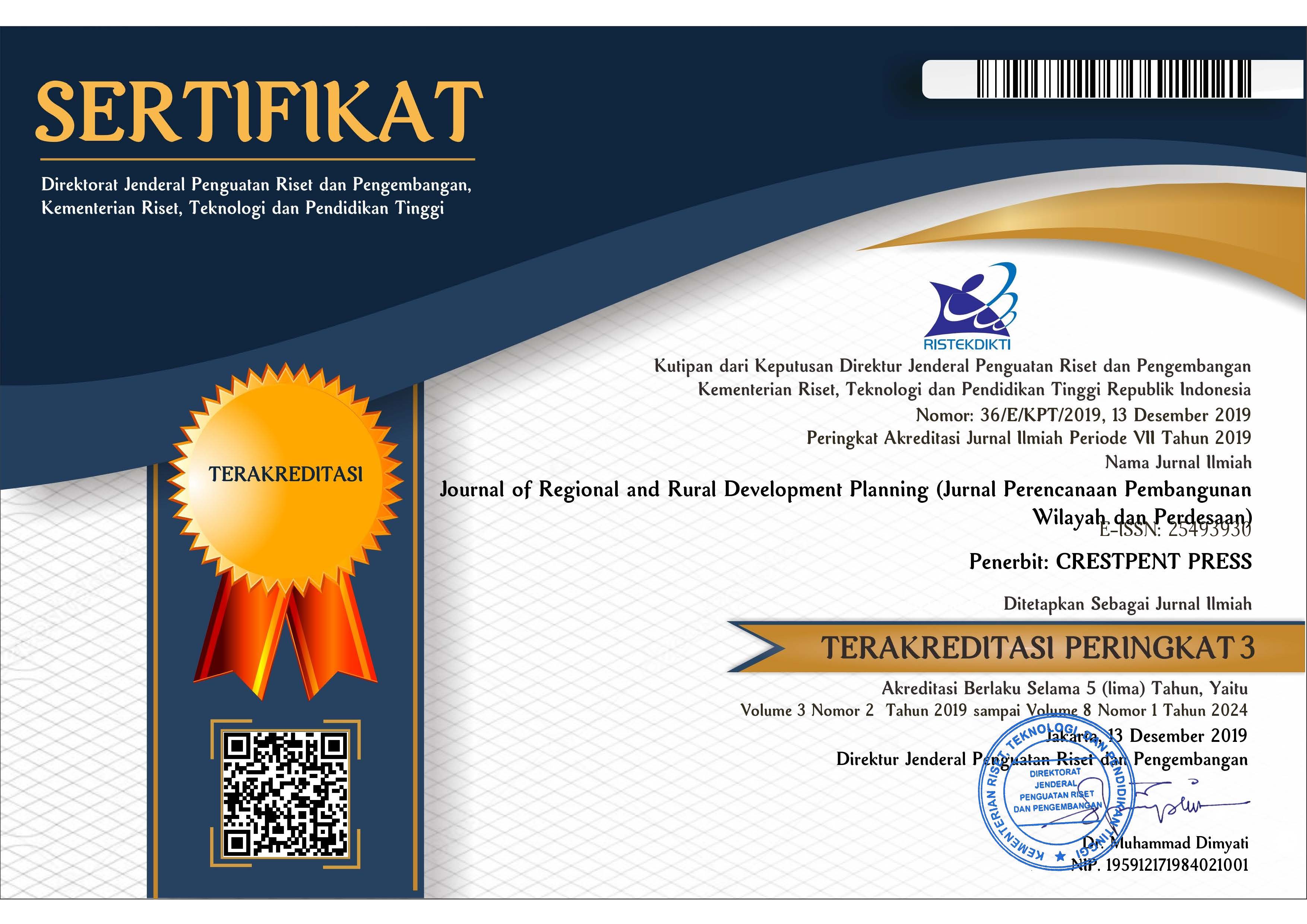GIS Application for Health Facility Coverage Mapping in Temanggung Regency, Central Java Province
Abstract
Adequate health facilities have become one of the interesting issues to be discussed since this pandemic situation. Availability and accessibility of health facilities are the vital aspects that should be accomplished by both local and central government. Nevertheless, some population especially those living in rural areas have some difficulties in reaching these facilities due to the inequality condition within regions. This study aims to analyze the coverage of health facilities in Temanggung Regency, Central Java province and cluster its subdistricts according to their condition in accessing these facilities. The analysis is limited to public health facility (PUSKESMAS) and hospital levels. Both statistical and spatial data were processed using the GIS network analysis approach in producing the coverage number of each health facility and they were compared to the applied standard range of service and threshold. Then, a hierarchy is created using the weighted centrality index approach to represent disparities among subdistricts in Temanggung Regency regarding the availability and its coverage to health facilities. The results show that there is an inequality condition on health facilities coverage between central and peripheral areas within this regency, both at the public health facility level and hospital level. Several population in several districts, mostly residing in outer areas, are not covered by both public health facility and hospital. On the other hand, people in the capital and its surrounding subdistricts have better access to these facilities. Several factors are identified in producing this inequality, such as spatial distribution of housing areas, spatial allocation of health facilities, road network, and topographic condition. The topographic condition in some uncovered areas, which is relatively hilly and has steep slope, causes limited access to the road network and less coverage of health facilities.
References
Alonso, W. (1968). Urban and Regional Imbalances in Economic Development Author ( s ): William Alonso Source : Economic Development and Cultural Change , Vol . 17 , No . 1 ( Oct ., 1968 ), pp . 1-14 Published by : The University of Chicago Press Stable URL : https://www.jst. Economic Development and Cultural Change, 17(1), 1–14.
Bibri, S. E., & Krogstie, J. (2017). Smart sustainable cities of the future: An extensive interdisciplinary literature review. Sustainable Cities and Society, 31, 183–212.
Bourdic, L., Salat, S., & Nowacki, C. (2012). Assessing cities: A new system of cross-scale spatial indicators. Building Research and Information, 40(5), 592–605.
Bull, C. N., Krout, J. A., Rathbone-McCuan, E., & Shreffler, M. J. (2001). Access and issues of equity in remote/rural areas. Journal of Rural Health, 17(4), 356–359.
Christaller, W. (1933). Central places in southern Germany.(Translated by Carlisle W. Baskin. Englewood Cliffs.) Prentice-Hall. New Jersey.
Dai, D. (2010). Black residential segregation, disparities in spatial access to health care facilities, and late-stage breast cancer diagnosis in metropolitan Detroit. Health and Place, 16(5), 1038–1052.
Daldjoeni, N. (1992). Geografi Baru Organisasi Keruangan Dalam Teori dan Praktek: Bandung. Penerbit PT Alumni.
Fauzi, M. R., Rustiadi, E., & Mulatsih, S. (2019). Ketimpangan, Pola Spasial, dan Kinerja Pembangunan Wilayah di Provinsi Jawa Timur. Journal of Regional and Rural Development Planning (Jurnal Perencanaan Pembangunan Wilayah Dan Perdesaan-JP2WD), 3(3), 157–171.
Friedmann, J. & W. Alonso (eds.) (1976). Regional development planning: the progress of a decade, in Friedmann dan Alonso (eds.) Regional Development and Planning: Readings in Theory and Applications. Cambridge: MIT Press, pp. 792- 808.
Hadeel, A. S., Jabbar, M. T., & Chen, X. (2011). Remote sensing and GIS application in the detection of environmental degradation indicators. Geo-Spatial Information Science, 14(1), 39–47.
Hazrin, H., Tahir, A., & Fadhli, Y. (2014). Implementation of Web based GIS Application for Mapping of Health Facilities, Services and Providers in Malaysia. Global Journals Inc. (USA), 14(5), 46–50.
Heywood, P. F., & Harahap, N. P. (2009). Human resources for health at the district level in Indonesia: The smoke and mirrors of decentralization. Human Resources for Health, 7, 1–16.
Irawan, B., & Ainy, A. (2018). Analisis Faktor-Faktor Yang Berhubungan Dengan Pemanfaatan Pelayanan Kesehatan Pada Peserta Jaminan Kesehatan Nasional Di Wilayah Kerja Puskesmas Payakabung, Kabupaten Ogan Ilir. Jurnal Ilmu Kesehatan Masyarakat, 9(3), 189–197.
Jensen, G. M., & Royeen, C. B. (2002). Improved rural access to care: Dimensions of best practice. Journal of Interprofessional Care, 16(2), 117–128.
Kompil, M., Jacobs-Crisioni, C., Dijkstra, L., & Lavalle, C. (2019). Mapping accessibility to generic services in Europe: A market-potential based approach. Sustainable Cities and Society, 47(June 2018), 101372.
Kristiansen, S., & Santoso, P. (2006). Surviving decentralisation?. Impacts of regional autonomy on health service provision in Indonesia. Health Policy, 77(3), 247–259.
Liew, H. P. & Gardner, S. (2014). Determinants of patient satisfaction with outpatient care in Indonesia: A conjoint analysis approach. Health Policy and Technology, 3(4), 306–313.
Liew, H. P. & Brooks, T. (2017). A conjoint analysis of inpatient satisfaction ratings in Indonesia. Health Policy and Technology, 6(1), 105–113.
Luo, J., Tian, L., Luo, L., Yi, H., & Wang, F. (2017). Two-step optimization for spatial accessibility improvement: A case study of health care planning in Rural China. BioMed Research International, 2017.
Munoz, U. H., & Källestål, C. (2012). Geographical accessibility and spatial coverage modeling of the primary health care network in the Western Province of Rwanda. International journal of health geographics, 11(1), 1-11.
Murad, A. A. (2007). Creating a GIS application for health services at Jeddah city. Computers in Biology and Medicine, 37(6), 879–889.
Nelson, J. A., & Gingerich, B. S. (2010). Rural health: Access to care and services. Home Health Care Management and Practice, 22(5), 339–343.
Páez, A., & Scott, D. M. (2017). Spatial statistics for urban analysis : A review of techniques with examples Author ( s ): Antonio Páez and Darren M . Scott Published by : Springer Stable URL : http://www.jstor.org/stable/41147914 REFERENCES Linked references are available on JSTOR for . 61(1), 53–67.
Putra, W. (2014). Efisiensi pelayanan publik bidang kesehatan pasca pemekaran wilayah Provinsi Kalimantan Barat. Jurnal Penelitian Dan Pengembangan Borneo Akcaya, 01(1), 1–16.
Polo, G., Acosta, C. M., Ferreira, F., & Dias, R. A. (2015). Location-allocation and accessibility models for improving the spatial planning of public health services. PLoS ONE, 10(3), 1–9. https://doi.org/10.1371/journal.pone.0119190
Roberts, A., Blunt, I., & Bardsley, M. (2014). Focus On: Distance from home to emergency care. In Quality Watch (Issue February).
Soares, L., Rustiadi, E., & Mulatsih, S. (2017). Analisis Disparitas dan Interaksi Spasial di Timor-Leste. Journal of Regional and Rural Development Planning, 1(1), 74.
Yin, C., He, Q., Liu, Y., Chen, W., & Gao, Y. (2018). Inequality of public health and its role in spatial accessibility to medical facilities in China. Applied Geography, 92(February), 50–62.
Zeng, D., You, W., Mills, B., Alwang, J., Royster, M., & Anson-Dwamena, R. (2015). A closer look at the rural-urban health disparities: Insights from four major diseases in the Commonwealth of Virginia. Social Science and Medicine, 140, 62–68.
Zwirowicz-Rutkowska, A. & Michalik, A. (2016). The Use of Spatial Data Infrastructure in Environmental Management:an Example from the Spatial Planning Practice in Poland. Environmental Management, 58(4), 619–635.
Copyright (c) 2021 Journal of Regional and Rural Development Planning (Jurnal Perencanaan Pembangunan Wilayah dan Perdesaan)

This work is licensed under a Creative Commons Attribution-ShareAlike 4.0 International License.




.png)














